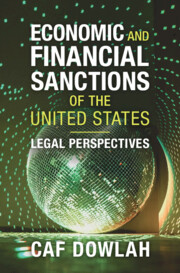Book contents
- Economic and Financial Sanctions of the United States
- Economic and Financial Sanctions of the United States
- Copyright page
- Dedication
- Contents
- Figures
- Tables
- Preface
- Table of Cases
- Table of Statutes and Regulations
- Conventions, Treaties, and Resolutions
- Presidential Executive Orders
- Abbreviations
- 1 Overview of Economic and Financial Sanctions
- 2 Economic and Financial Sanctions under International Law
- 3 Legal Frameworks of US Economic and Financial Sanctions
- 4 Enforcement Infrastructures of US Economic and Financial Sanctions
- 5 US Economic and Financial Sanctions against the Russian Federation
- 6 US Economic and Financial Sanctions against the Islamic Republic of Iran
- 7 US and Multilateral Sanctions Regimes against the Republic of Iraq
- 8 US Economic and Financial Sanctions against the Republic of Cuba
- 9 US Economic and Financial Sanctions against the Bolivarian Republic of Venezuela
- Index
- References
7 - US and Multilateral Sanctions Regimes against the Republic of Iraq
Published online by Cambridge University Press: 22 March 2025
- Economic and Financial Sanctions of the United States
- Economic and Financial Sanctions of the United States
- Copyright page
- Dedication
- Contents
- Figures
- Tables
- Preface
- Table of Cases
- Table of Statutes and Regulations
- Conventions, Treaties, and Resolutions
- Presidential Executive Orders
- Abbreviations
- 1 Overview of Economic and Financial Sanctions
- 2 Economic and Financial Sanctions under International Law
- 3 Legal Frameworks of US Economic and Financial Sanctions
- 4 Enforcement Infrastructures of US Economic and Financial Sanctions
- 5 US Economic and Financial Sanctions against the Russian Federation
- 6 US Economic and Financial Sanctions against the Islamic Republic of Iran
- 7 US and Multilateral Sanctions Regimes against the Republic of Iraq
- 8 US Economic and Financial Sanctions against the Republic of Cuba
- 9 US Economic and Financial Sanctions against the Bolivarian Republic of Venezuela
- Index
- References
Summary
This chapter spotlights the profound impact of the comprehensive and tragic sanctions imposed on Iraq during the 1990s. These multilateral and bilateral sanctions, ostensibly aimed at eliminating non-existent weapons of mass destruction, led to a devastating humanitarian catastrophe, claiming around two million lives, largely children. The chapter delves into intricate dynamics, including US interventions, military actions, regime changes, and foreign occupation until 2011. It examines how these sanctions shaped pre- and post-invasion crises and systemic corruption. Legal dimensions are explored, probing issues of genocide, human rights violations, and international charters, revealing a complex web of consequences, actions, and implications within this historical context.
Keywords
- Type
- Chapter
- Information
- Economic and Financial Sanctions of the United StatesLegal Perspectives, pp. 234 - 271Publisher: Cambridge University PressPrint publication year: 2025

